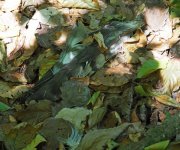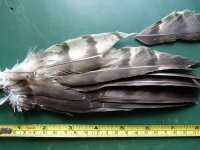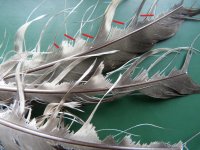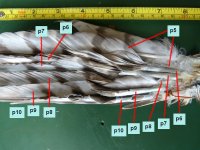Biancone
to err is human
I recently (29 July) found some feather remains of an almost fully fledged Goshawk Accipiter gentilis (thanks to Peter Sunesen for confirming the ID). Some feathers show distinctive damage and I wonder if it is feasible to reconstruct what might have befallen the youngster.
The remains were found on the woodland floor about 15 metres downslope from the nest tree. There were two bunches of wing feathers, and several smaller individual feathers within the same area, but certainly not a complete set of flight feathers, no scattering of body feathers, and no tail, body or legs. The biggest of the two bunches is shown in situ in the first (left) image, and isolated in the second image. It consisted of much of the hand of the left wing.
There are several trees and patches of ground cover between the nest tree and the tree nearest to the remains, and the remains were found on the downslope side of the latter, within a relatively flat area about one metre in diameter immediately behind the trunk . So, it seems unlikely that the fledgling died or was killed and then dismembered in the nest, because the feathers could not have found their own way to where I found them. Either something took the fledgling from the nest, or it fell from the nest and was grounded. Presumably it must then have died or been killed, and any substantial remains could have been taken by scavengers. Is that a reasonable conclusion? Mammalian predators/scavengers in the woods certainly include Beech Marten Martes foina and Fox Vulpes vulpes. The second image shows at top right a distal section of feather that has broken or been removed from the basal section.
Some feathers look as if the barbs have been neatly snipped off, at a rather consistent angle (red lines in image 3 indicate some of these). Does this look familiar to anyone? Is it likely that a raptor has caused this damage with its beak? I wondered if this damage could suggest that a raptor took the fledgling from the nest, killed it on the ground nearby, and took the body with it. Perhaps a more advanced sibling was responsible, or an unrelated Goshawk? There are (allegedly) Eagle Owl Bubo bubo in the region but I have not seen or heard one here. Or might this damage have been inflicted previously while still in the nest?
Finally, the right-most image shows the ventral side of the partial hand. It shows that the outermost primaries are still in the process of emerging from the basal sheath and show more or less wavy edges that seem to reflect the helical growth pattern within the sheath. Would anyone with experience of young Goshawk in the hand be able to suggest probable time since hatching, and/or time until flight?
Thanks for any thoughts.
Brian
The remains were found on the woodland floor about 15 metres downslope from the nest tree. There were two bunches of wing feathers, and several smaller individual feathers within the same area, but certainly not a complete set of flight feathers, no scattering of body feathers, and no tail, body or legs. The biggest of the two bunches is shown in situ in the first (left) image, and isolated in the second image. It consisted of much of the hand of the left wing.
There are several trees and patches of ground cover between the nest tree and the tree nearest to the remains, and the remains were found on the downslope side of the latter, within a relatively flat area about one metre in diameter immediately behind the trunk . So, it seems unlikely that the fledgling died or was killed and then dismembered in the nest, because the feathers could not have found their own way to where I found them. Either something took the fledgling from the nest, or it fell from the nest and was grounded. Presumably it must then have died or been killed, and any substantial remains could have been taken by scavengers. Is that a reasonable conclusion? Mammalian predators/scavengers in the woods certainly include Beech Marten Martes foina and Fox Vulpes vulpes. The second image shows at top right a distal section of feather that has broken or been removed from the basal section.
Some feathers look as if the barbs have been neatly snipped off, at a rather consistent angle (red lines in image 3 indicate some of these). Does this look familiar to anyone? Is it likely that a raptor has caused this damage with its beak? I wondered if this damage could suggest that a raptor took the fledgling from the nest, killed it on the ground nearby, and took the body with it. Perhaps a more advanced sibling was responsible, or an unrelated Goshawk? There are (allegedly) Eagle Owl Bubo bubo in the region but I have not seen or heard one here. Or might this damage have been inflicted previously while still in the nest?
Finally, the right-most image shows the ventral side of the partial hand. It shows that the outermost primaries are still in the process of emerging from the basal sheath and show more or less wavy edges that seem to reflect the helical growth pattern within the sheath. Would anyone with experience of young Goshawk in the hand be able to suggest probable time since hatching, and/or time until flight?
Thanks for any thoughts.
Brian







